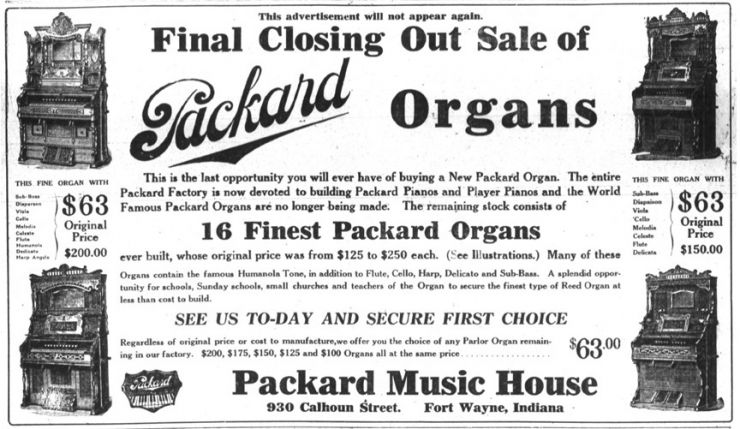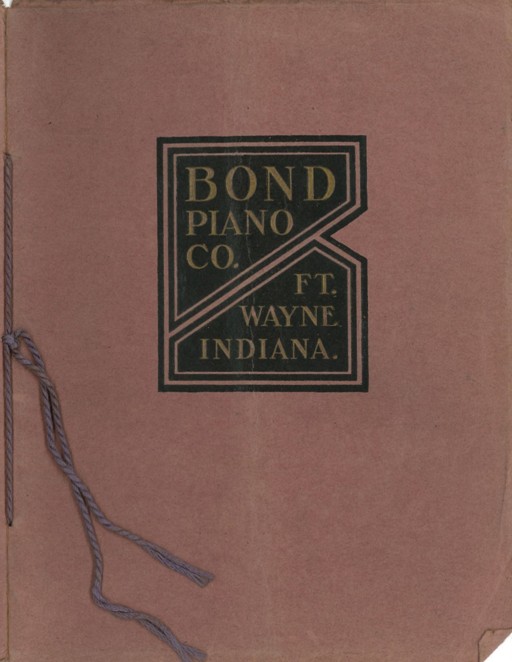1912 – A Year of Transition for Packard
On Sunday, May 12, 1912, the following announcement appeared in the Fort Wayne Journal- Gazette:
Operations at the Packard Piano and Organ factory will be resumed sometime this week, it is stated, and the men out of employment since the shut-down on Saturday, April 27th, will then be recalled. Two-thirds of the force employed at the factory were laid off at that time and various improvements have been carried out at the factory since, including the installation of new machinery and some shifts in the various departments.
The piano workers have continued their efforts to increase the membership of their union, recently organized in this city, and they claim that the majority of the men employed at the factory are members of their organization now.
Prior to April, the president of Packard, Albert S. Bond, had allowed the workers in the piano factory to organize a union. Once the majority of the workers had joined, its leader approached the president and demanded that all employees join or they should be dismissed.
While Mr. Bond did not discourage union organization or membership, he refused to fire or let go those who chose not to join. The union threatened to strike, but before they could carry out the threat, Bond closed the factory down with the public excuse that they were doing so “for repairs and installing machinery” in the plant. By May 12, the time of the announcement, the strike had been broken and workers were being allowed back in the plant.
Just over a month later on June 13, another announcement appeared with the bold headline of “NEW $100,000 BOND PIANO CO.; THE PACKARD ORGANS SILENT.” It went on to state:
Mr. Albert S. Bond, president of the Packard Piano company, announces the organization of the new Bond Piano company, with a capital of $100,000 equally divided into common and preferred stock.
The new company will occupy that portion of the Packard building, on Fairfield avenue heretofore devoted to Packard organs, the manufacturer of which will cease with the filling of orders to date.
The new Bond company is organized to manufacture the Bond piano, destined to take the place of old-style organs as a medium-priced instrument in the modest homes of the land.
The Packard company will continue the manufacture of the high-grade and high-priced Packard piano. That instrument enjoys a field and fame that is nationwide materially and musically in the highest class.
The new Bond company was formed some time ago and while distinct from the Packard company, the stockholders are practically identical. The division of the capital invested and the changed name were made to meet objections that naturally would arise in marketing two grades of Packard pianos.
The Packard company, Mr. Bond said, found the market for organs narrowing yearly and the people were naturally looking for a popular-priced piano, and this demand the Bond piano is designed to meet, for the new company will put it within the financial reach of fathers and mothers who want to please their children and grace their homes with pianos.
The decision of the Packard company to cease the making of organs, was the occasion of a rearrangement at the factory and a reassignment of the working forces and while the changes may retire some of the men for a time, the launching of the new industry will call them back, in truth the new company will more than double the working force at the Packard plant, since the Bond piano is sure to meet phenomenal sale, in fact the inquiries of the trade already warrant that assertion.
The new company with the capital invested and the men interested insures Fort Wayne a new industry surpassing calculations for the Bond piano will leap into popularity.
The new company is perfected, its stock subscribed and incorporation papers have been forwarded to the secretary of state.
Fort Wayne will hail the new corporation with hearty words of cheer and the enlargement of the working forces and addition to the Fairfield avenue plant will feature the future of the popular Bond piano.
The passing of the celebrated Packard organ marks the end of a great era, but like all good things it worked its way into a larger and richer era and the people are living in the piano age.
While the public announcement and filing with the state of the formation of the Bond Piano Company was delayed until June the following year, the Articles of Incorporation had been presented before a notary on September 22, 1911. Undoubtedly the planning to move ahead with increased piano production and the cessation of organ production was in the works. Even though the strike precipitated the closing of the plant in April, its closure allowed for the restructuring internally within the facilities as they moved towards their new goals.
Once the announcement had been made about Packard organs becoming silent, the focus moving forward was to fill any outstanding orders and to coordinate with their organ distributors and dealers around the world. This of course necessitated some time, considering among other factors the time lapse needed to correspond effectively with far-flung dealers.
The end was finally reached late in 1913, some seventeen months later. On November 9, a large half-page ad appeared in the Fort Wayne Journal-Gazette (and other local newspapers) announcing the final sale of organs (Fig. 15). Thus, the final chapter in Packard’s proud tradition of manufacturing of reed organs came to a close.
And what of the Bond piano? On September 22, 1911, ten men from Fort Wayne, Indiana, met before a notary to have Articles of Incorporation notarized for the formation of the Bond Piano Company. The ten gentlemen were Albert S. Bond, John H. Bass, Herbert W. Bond, S. Charles Bond, Gaylord M. Leslie, James M. Barrett, John M. Kuhns, William H. Simmons, Charles J. Scheinmann, and William H. Wiebke. In an apparent effort to shield the public from these changes, there was no announcement made, nor was the application filed with the Secretary of State until June 1912, at which time they announced not only the end of organ production, but also the beginning of the manufacturing of the Bond piano.
The announcement would have been surprising, if not outright shocking, for both the public and the workers in the plant. With this eventual announcement, the wheels had been set in motion to shift into high gear for the introduction of the new Bond piano. There may have been prior rumors, but now there was no question that there would be a major shift inside the manufacturing complex.
Not wanting to work a hardship on the organ manufacturing workers, management made it possible for them to transfer into piano departments. One such worker was William F. Sabin. He had begun to work for the Packard company in 1893 as an organ tuner. He transferred into the piano department by 1915 and became a piano tuner. Even though The Packard Piano Company went into receivership in 1930, he was listed as still working in the factory in 1931. He apparently was part of a team helping to close out the plant.
In the introductory Bond catalog (Fig. 16), six pages are devoted to convincing prospective buyers that “The product itself is the answer to the problem that has confronted the trade – how to produce an instrument of high total quality, artistic design and enduring excellence at moderate cost.” The catalog contained four upright styles and two player piano styles.
In this early catalog there is no mention of any connection with the Packard company. This changed in later advertising while still stressing that “The Bond Piano is made by the Bond Piano Company, a separate and distinct organization from The Packard Piano Company, employing a separate force of men.”
In an annual report filed August 17, 1914, it was reported that, “This company sold out Jany [sic] 1913. Has no officers at present nor directors” with no capital stock issued and none outstanding. I know of no explanation as to why this action was taken. Advertisements now emphasized that the Bond piano was being marketed and guaranteed by The Packard [Piano] Company. Annual reports continued to be filed until 1925, at which time legal steps were taken to dissolve the company.
A valid question one might ask is, “Why produce a Bond piano?” The answer is best explained by a quote from a ca. 1917 Bond Piano Company catalog:
During all these years the instruments made bore the name Packard. After Mr. Stephen B. Bond was taken to his reward his sons and their associates, who loved and revered him, thought to find some way of perpetuating his name with the business which, under his able and wise guidance of nearly 40 years, had grown from a Twenty-five Thousand Dollar to a Million Dollar Concern, and it was decided to bring out the Bond piano.
****************************************************************************************************************

Fig. 15. Organ closing out sale ad, November 9, 1913.

Fig. 16. 1912 Bond Piano catalog cover (ACFWHS collection)
